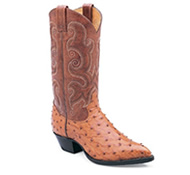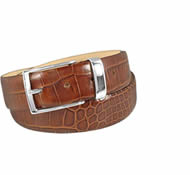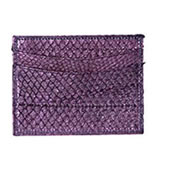You were wondering...
Where did all those fashionable exotic leathers come from and how did they become bags, belts, shoes, wallets and such like? You've got a thing or two about stingray leather? You've come to the right place. Whether it's a colorful stingray handbag or black leather jacket, here we will discuss all the various exotic leathers and give a summary of each type of them: what are the animals characteristics, how the skins are produced or harvested and finally how they become the fashion products.
The menu on the left shows the different types of exotic leathers.
History of a modern Leather Handbag
The first documented use of handbags is from fourteenth century hieroglyphics, showing men carrying little pouches around their waists called 'girdles' for carrying flint. However by the 1400s women as well as men were wearing handbags adorned with jewelry or embroidery to reflect their wealth and these objects became a status symbol, depicted in portraits of affluent and influential people proudly sporting their handbags fastened to their outfits with tasseled strings.
By the early seventeenth century men and women's leather handbags had virtually disappeared and were replaced by pockets under their clothes. Black leather jackets were also not what they are now. By the close of the eighteenth century puffed skirts were out of fashion for women and close fitting dresses became the in thing. Leather and embroidered handbags became popular as handbags started to complement their clothes and women had different leather handbags for different occasions. Perfume, smelling salts, fans and visiting cards were carried in women's handbags and these handbags were called 'reticules'.
It was not until the 1900s that the term 'handbag' first emerged, to describe satchels and briefcases carried by men. However designers of women's handbags made similar versions to suit feminine needs including tiny compartments for fans, gloves, opera glasses and makeup.
The years after the First World War witnessed the physical freedom of women and a more independent attitude to women emerge and this is when handbags really became indispensable accessories. Handbags really came into their own, with different materials including mother of pearl and bolder colours being used and the discovery of Tutankhamun's tomb was also reflected in handbags and purses of the time.
The outbreak of the Second World War meant a shortage of leather and metal for frames and zips, so handbag manufacturers started using wood and plastic instead. The 1930s and 1940s also saw the development of the clutch bag - which are still very popular today and websites such as SexyHandbags offer a wide range of clutch bags in various different designs and colours to suit all tastes.
It was not however until the 1950s that fashion houses developed producing designer leather handbags and in the 1960s reptile skin and silk handbags came into fashion. Again silk handbags are still very much in vogue as occasional bags and SexyHandbags stocks a large selection of stunning silk embroidered leather handbags.
Today the majority of leather handbags come from Italy and China, which is where SexyHandbags sources its leather handbags from and we have recently seen a trend for handbags made from wool and tweed, such as many of SexyHandbags' stylish winter leather handbags, like the Autumn Rose, the Poppins and the Patchwork winter handbag.
Improvements in manufacturing processes have also meant that handbags can now be produced much cheaper, allowing people to buy beautiful handbags at affordable prices and this has long been the ethos of Sophie Curtis' website SexyHandbags which sells a huge range of stunning handbags, clutch bags, silk handbags, purses and jewelry wraps at very reasonable prices to suit all pockets, styles and tastes.



